DELVENE COCKATOO-COLLINS
Delvene Cockatoo-Collins is a Quandamooka woman and artist who lives and works on Minjerribah - North Stradbroke Island, operating her
practice through a studio and retail store in Goompi – Dunwich.
Recurring themes across Delvene’s artwork and expressions are the stories of her family’s lived experiences on Quandamooka Country, her
responses to images and texts related to her family, the relationship to her great-great grandmother, through a body of work, titled Six
Generations, Traditional mat making techniques, and the use of clays and pigments found across Quandamooka including the islands and
mainland around Moreton Bay. It was Delvene's Grandmother Bethel Delaney who wrote the words 'dilly bag and mat making as Granny did' and
spoke 'A Mermaid in the Bay' which inspires Delvene's work in art and wearable art.
Delvene's works are currently on display at Linden until 27 November 2022.
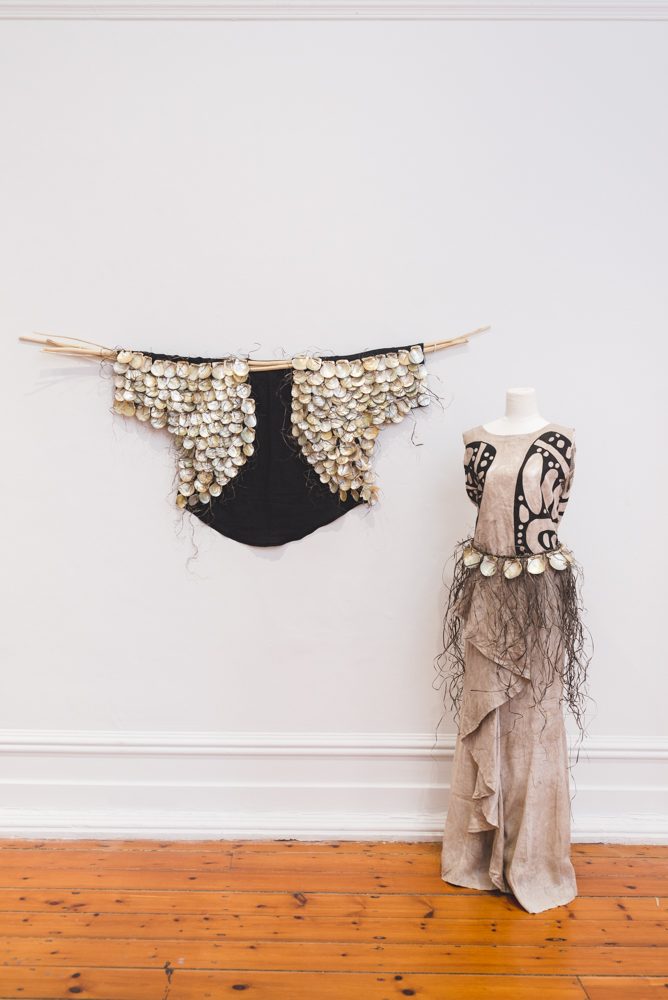
IMAGE > Delvene Cockatoo-Collins, A Mermaid in the Bay [installation view], 2022, linen, natural fibres including
tawalpin - cotton tree and banksia, quampie shells, dimensions variable. Image courtesy of the artist and Mob in Fashion.
Photograph: Theresa Harrison Photography.
This collection 'A Mermaid in the bay' utilises quampie shells as part of traditional gathering practices by Delvene's family and cooked by Delvene's mother to form the mermaid patterns on the skirt. The shells are stitched with gathered natural fibres from the island - the tawalpin or cotton tree onto a linen fabric that is naturally dyed by banksia bark collected with Delvene's brother Corey - following the fire trails work he did in 2022 as part of his work as a ranger. This story is about family and made with family.
Delvene Cockatoo-Collins, 2022
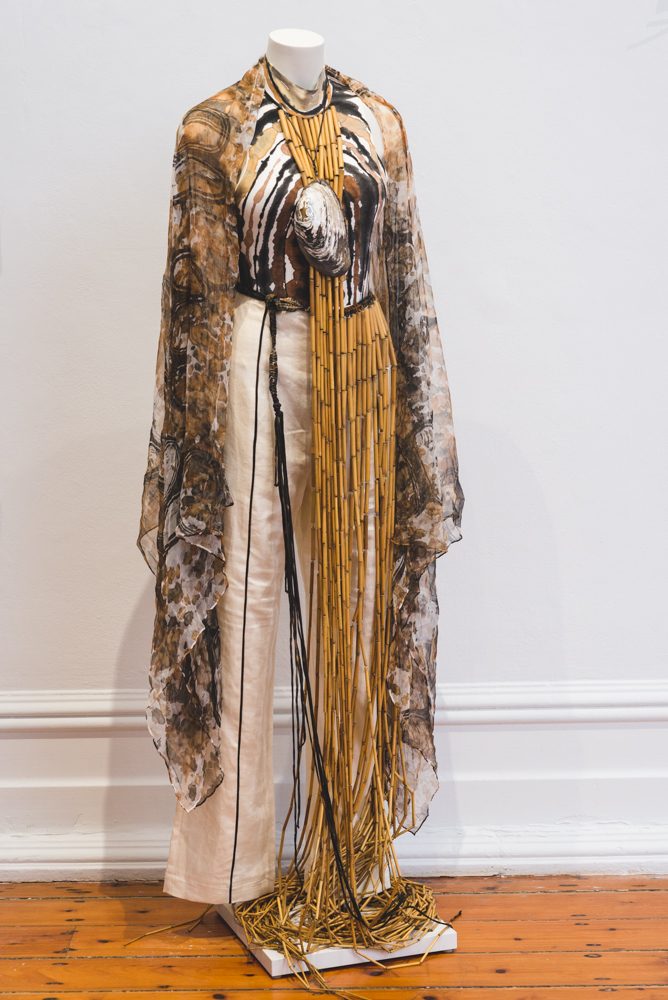
IMAGE > Lillardia Briggs-Houston, Gubudha (Reed) [installation view], 2022, reed, linen, thread, dye, dimensions variable.
Image courtesy of the artist and Mob in Fashion. Photograph: Theresa Harrison Photography.
Be bold
LILLARDIA BRIGGS-HOUSTON
Lillardia Briggs-Houston is a Wiradjuri, Gangulu, Yorta Yorta artist and fashion designer based in Narrungdera/Narrandera, Wiradjuri
Country. She produces all her textiles works and garments herself by hand on country adapting traditional Southeast Aboriginal cultural
practices like carving, bush dying and weaving into her work. Preferring slow, respectful production to ensure her cultural integrity and
sustainable values are upheld and at the forefront of her work.
Lillardia studied fashion at TAFE NSW and has a long history with garment production being taught by her trained Wiradjuri grandmother from a
young age. In 2017, she merged her own storytelling through Aboriginal art with her skills in fashion and has continued to create First
Nations textiles and garments that share her love of culture and fashion ever since.
Lillardia’s label was established in 2019 to assert self-determination and empowerment through fashion and textile. Her work has since
showcased at Australian Fashion week and Melbourne fashion week, featured in publications such as Vogue Australia, Marie Claire, The
Australian, Wild Wellbeing and Peppermint magazine. She was a nominee for the inaugural 2021 ‘Indigenous designer of the year’ at the
Australian Fashion Laureate, dual nominee at the National Indigenous Fashion Awards for three consecutive years and recently in 2022 won the
‘Wearable art’ category.
Through each of Lillardia’s culturally and environmentally sustainable textile and garments, she respectfully highlights the strength,
pride, and connection that she feels as a First Nations woman with the aim to use fashion as a catalyst for change that respect and honour
cultural values and integrity.
Lillardia's work is currently on display at Linden until 27 November 2022.
'Gubudha' (reed) reflects on reed that lines the banks of freshwater sources on country. A staple food and resource used by First Nations communities for tens of thousands of years. This work was created with repurposed materials that honour circular fashion and textiles. Reusing and repurposing items into wearable garments that honour cultural and environmental sustainability.
Lillardia Briggs-Houston, 2022
CASSIE LEATHAM
Cassie Leatham is a Taungurung and Dja Dja Wurrung woman of the Kulin Nation. Cassie is a multidisciplinary artist and fashion and jewellery designer, cultural educator, master weaver, author and illustrator and has had a 35 year career span creating with a variety of mediums with numerous exhibitions nationally and internationally and with her works been acquired by the National Gallery of Victoria, Town Hall Gallery, Melbourne Magistrates Courts, Koorie heritage Trust and private collectors. Cassie has recently launched her fashion brand Yanggurdi and is also the founder of Wild Blak Arts, Cassie creates traditional designs and also contemporary with drawing on environment impact in mind. Cassie’s designs are created using natural materials collected from country and carry significant story’s of her personal journey being a First Nations artist. Cassies deigns have been exhibited in MagNT, KHT, Denfair, Melbourne Design week, Milan Italy and recently at Melbourne fashion festival and NIFA with the launch of Yanggurdi.
Cassie's work is currently on display at Linden until 27 November 2022.
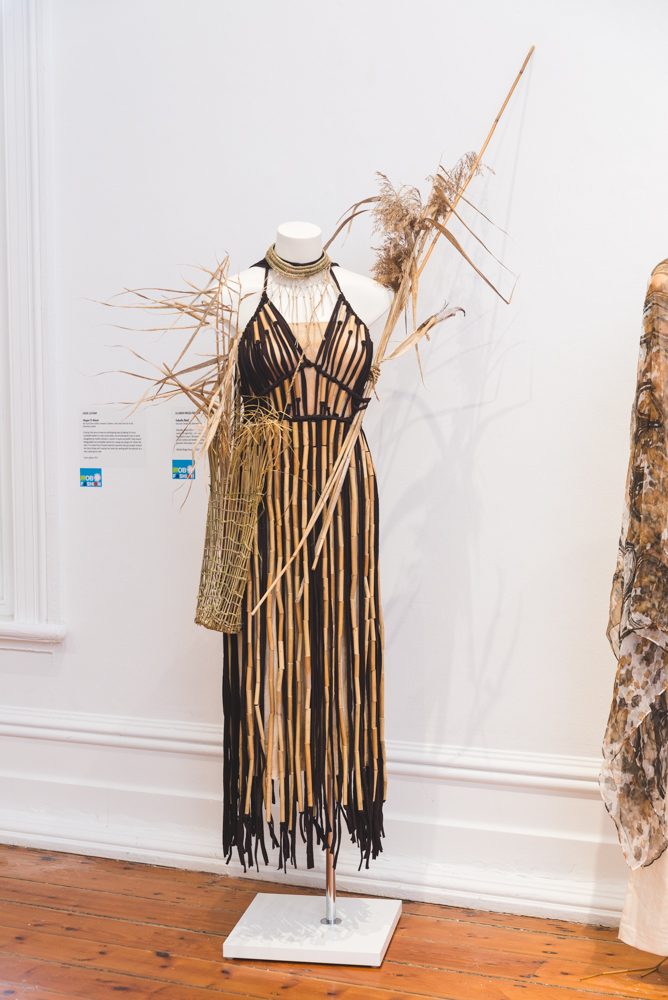
IMAGE > Cassie Leatham, Mungan (To Weave) [installation view], 2022, silk, found native feathers, lomandra, pandanus, native
plant bush dye on silk, dimensions variable. Image courtesy of the artist and Mob in Fashion. Photograph: Theresa Harrison Photography.
Creating from natural resources and designing ways of making for future sustainable fashion to create conversations into environmental
issues of waste management as fashion clothing is a concern in waste and landfill. Using natural biodegradable and sustainable material
for creating new designs for fashion this work I’ve created from all natural materials represents the past brought forward into future
design with creating from nature but working with the materials for a more contemporary look.
Cassie Leatham, 2022
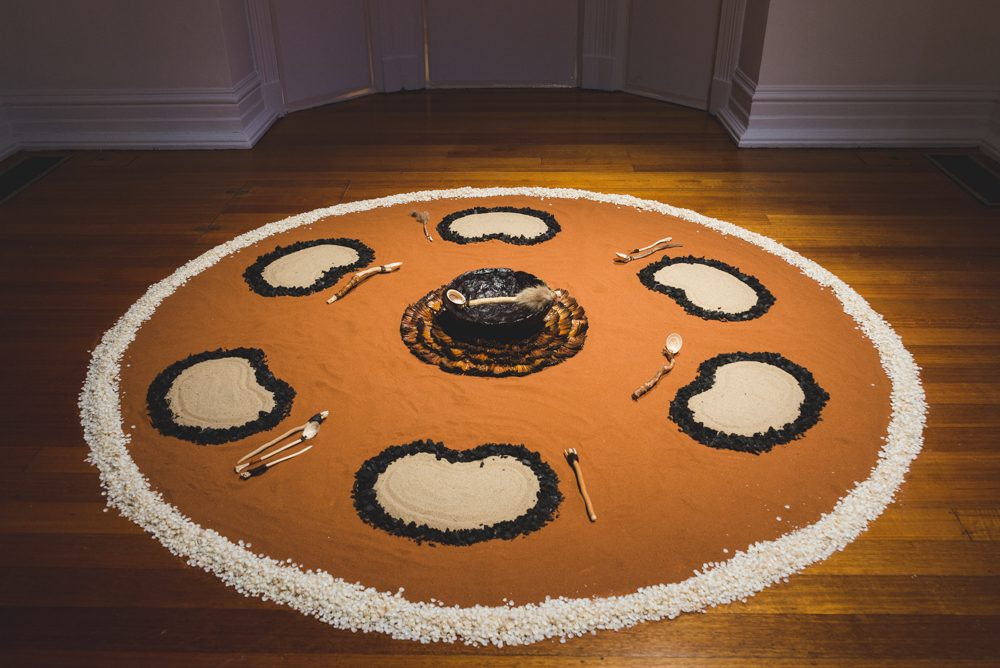
IMAGE > Nicole Monks, birli nganmanha (eating together) [installation view], 2021, grass tree resin, kangaroo skatt, charcoal,
driftwood, river reed, shell, acacia and kangaroo teeth, echidna quill and eucalyptus, dimensions variable. Image courtesy of the
artist. Photograph: Theresa Harrison Photography.
NICOLE MONKS
Nicole Monks is a multi-disciplinary creative of Yamaji Wajarri,Dutch and English heritage living and working on Worimi and Awabakal Country (Newcastle). Monks’s practice is informed by her cross-cultural identity, using storytelling as a way to connect the past with the present and future. Her works take a conceptual approach that are embedded with narratives and aim to promote conversation and connection.
An award-winning designer and artist, Monks crosses disciplines to work with furniture and objects, textiles, video, installation and performance. Across these varied forms of contemporary art and design, her work reflects Aboriginal philosophies of sustainability, innovation and collaboration. Monks is well known for her success as a solo and collaborative artist and founder of design practice blackandwhite creative as well as public art company mili mili.
Nicole's work is currently on display at Linden until 27 November 2022.
When we made this work, I was travelling with my family on Yamaji Country, the Country upon which my ancestors have existed over millennia. On Yamaji Country, you are surrounded by an abundant environment full of natural materials that mob have worked with since the beginning of time. These materials are not simply resources from which tools could be crafted, but in themselves they are stories of cultural knowledge shared through generations, and geographies of space and time. Through combining locally abundant materials like the grass-tree resin exposed by cultural burns, kangaroo skatt and charcoal, (today we would refer to this as a type of thermoplastic fibreglass) we are able to chemically and mechanically engineer utilitarian multi-purpose tools and weapons of high quality and durability for domestic application.
Whilst on Country, I was considering the complex stories behind these traditional materials that were transformed into everyday cultural belongings over such a long time. These natural materials connect us to nature and each other; the rituals surrounding their manufacturing; the collecting and foraging; the seasonal relocation, the particular smells of regions and what creates a ‘home’; the cultural burns; the grinding; and learning and knowledge transfer in the creation of a thriving lifestyle and connected community. How the materiality of an object was the starting point for it stretching out to these deeper facets of cultural upkeep fascinates me.
In considering this I asked myself: could this materiality and connection be integrated into my home
today? How could I keep
my connection to country and express my culture and belonging within my belongings. I’m of mixed heritage, and with Australia being a
colonised country, I’ve been developing the ideas of a western table setting made from natural materials found journeying to and on Yamaji
Country. And how this expresses the time and place I find myself today.
Nicole Monks, 2021
ROBYN, SIÂN
AND DANIÈLE HROMEK
Robyn, Siân and Danièle, are Budawang women of the Yuin Nation. As part of a wider family network we work to reclaim and develop our
cultural practices, including creating woven pieces and net making. Our work often responds to our experiences on Country, both in the
countryside and the city, and how these different relationships with Country affect our practices. Our work also includes narratives of
family, and tells the stories carried through the generations of love, loss, colonisation and resilience. As a family group undertaking the
work together, we explore what narratives, memories and histories will be caught by our net making, and what stories might spill out of our
woven creations. Robyn is Danièle and Siân’s mother. Outside of our explorations with fibres, Siân works in land management including
cultural burning, Danièle is a researcher in spatial disciplines and Indigeneity, while Robyn is a school counsellor and lecturer.
Robyn, Siân and Danièle Hromek's work is currently on display at Carlisle Street Art Space, St Kilda Town Hall, until 27
November 2022.
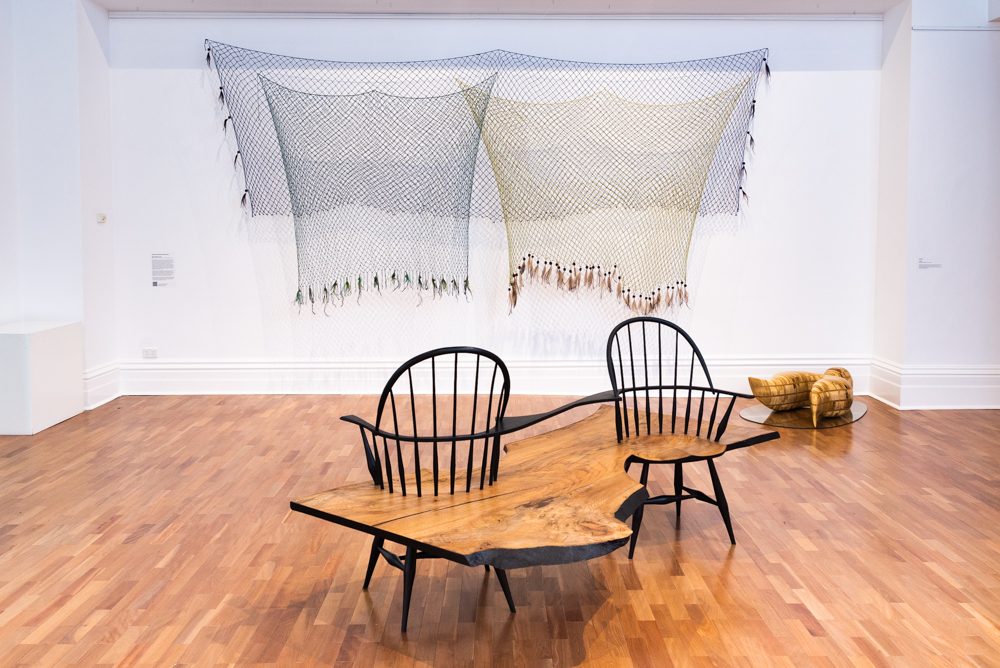
IMAGE > Robyn, Siân and Danièle Hromek, Djinjama: Defying the Grid [installation view], 2021, twine, natural dyes, gum, nuts,
casuarina nuts and emu feathers, dimensions variable. Image courtesy of the artist.
Photograph: Theresa Harrison Photography.
Aboriginal people have always been designers of space, using techniques such as cultural burning along with other land management and cultivation practices. Yet when urban spaces were designed in Australia, First Peoples were largely left out of the design process. Subsequently, they were moved out of civic spaces, and made to seem as if “real” Aboriginality was from a long way away and a long time ago. Nonetheless today more First Peoples have their homes in urban centres than remote or non-civic settings.
Women's cultural practices in our family take place in or near the home, usually involving teaching, making, laughter, food and tea. This is how our family continued to pass down our crafting practices; by safekeeping them in the confines of the home, sharing them among activities of creating a safe home for our family.
Danièle Hromek, 2021
